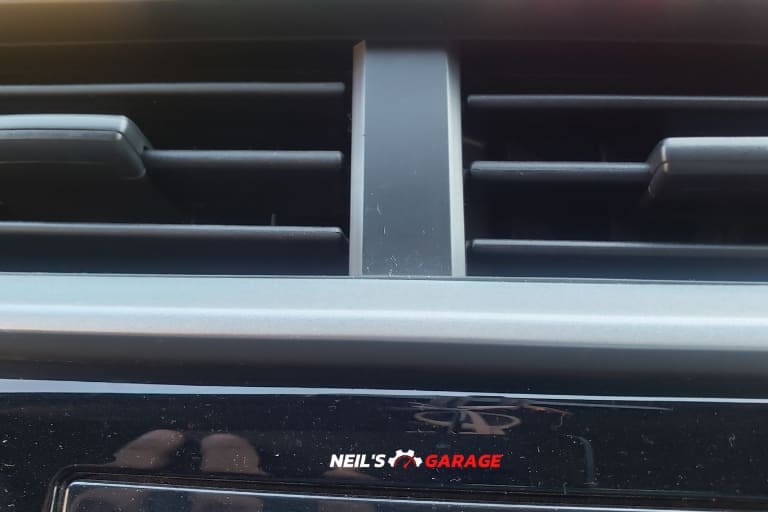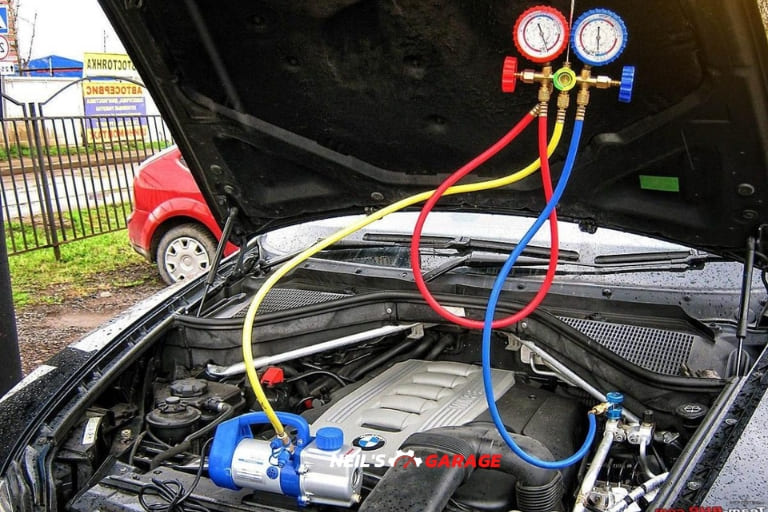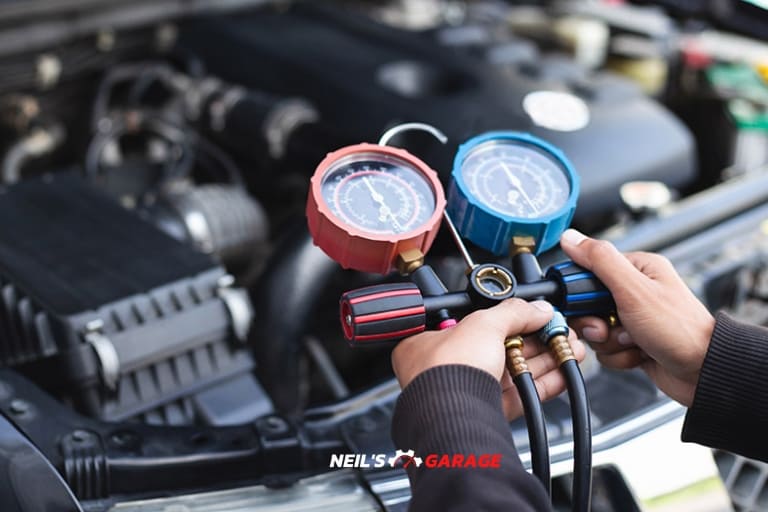Have you observed a drop in your car’s air conditioner’s cooling capacity? If yes, it may be time to think about an AC recharge. The slow loss of refrigerant, wear and tear, or possible leaks may cause an AC’s inefficiency. However, it’s crucial to precisely identify the underlying issue before trying a DIY recharge.
In this article, we’ll examine the warning indications of a low refrigerant level, the significance of the air conditioning system, and the best way to guarantee that your car’s cooling system runs at peak efficiency. We will also discuss the signs your car’s ac needs to be recharged, and you can recharge the car on your own.
Let’s get started without any further ado!
Contents
Does my car’s ac need to be recharged?
If you notice any signs, such as warm or hot air flowing from the vent rather than cold air, the AC clutch not engaging when you switch on the AC, or refrigerant leaks on the AC components or beneath the car, your car’s air conditioning system needs to be recharged.
Signs your car’s ac needs to be recharged

The air coming out of the vents is warm or cool.
If the air flowing from the vent feels a little warm to you, the refrigerant level may have dropped, impacting how well the air conditioner’s cooling efficiency. Low refrigerant levels can harm the vehicle’s air conditioning system and other components as well. The ability of the system to absorb and release heat from the automobile compartment is hampered by low refrigerant levels, which also lowers cooling efficiency overall.
The air conditioner doesn’t blow as cold as it used to.
If the car ac is not blowing as cold air as it used to blow before, your car’s air conditioning system may need a recharge. The level of refrigerant may naturally deplete over time, and as the level of refrigerant drops, it affects and reduce the cooling efficiency of the Air conditioning system.
The AC clutch fails to engage.
The AC compressor clutch is in charge of turning on and off the AC compressor. If the clutch fails to engage, this can indicate low refrigerant. Recharging your air conditioning system can help you fix the issue and return the system to normal operation.
The air conditioner doesn’t come on at all.
If your car’s air conditioner doesn’t turn on at all, it could be time to recharge it. The AC system’s low-pressure safety switch may prohibit the compressor from starting to prevent harm when the refrigerant level drops considerably.
How to recharge your car AC
Here is a step-by-step guide for you to follow to recharge your car AC on your own:
Step 1: Check the refrigerant levels.

The first step is to check the refrigerant level of your car’s air conditioning system. Use a pressure gauge to measure the pressure of the car’s Air conditioning system. If the instrument reading comes below the prescribed reading, it shows low pressure. Low pressure may indicate you need an immediate recharge.
You must do the following actions to measure the refrigerant level using a pressure gauge:
- Connect the red hose (on your gauge face. If it’s analog, it will be red) to the high-pressure part of your system; this will, again, be the smaller of the pipes, sometimes insulated but not very often.
- To the low-pressure portion of your system, attach the blue hose.
- Vent/Purge.
- Examine the connections, particularly those on Stubby’s.
- Note the readings.
Step 2: Add refrigerant if necessary.
If the reading in the pressure gauge is below normal, you will need to add extra refrigerant to the system. This may be accomplished by getting a refrigerant can from an auto parts store and using it as directed.
You may follow the following steps to refill a refrigerant:
- Find out what kind of refrigerant your system uses, then buy the required accessories like a charge kit, service valve, tap valve, and refrigerant can.
- Locate the compressor and the low-pressure port after turning off your system.
- Connect the hose from the refrigerant container to the port after removing the low-pressure port lid.
- Activate your system and raise the A/C to its highest setting.
- Check the refrigerant pressure by reading the gauge on the refrigerant container. You need to add refrigerant if it is low.
- Slowly add refrigerant while keeping an eye on the gauge readings. Avoid over-pressurizing the system.
- Remove the hose and put the leftover refrigerant in storage. The low-pressure port cap should be replaced.
Step 3: Test the air conditioner.
After you recharge your air conditioning system, test the ac to ensure the process is accomplished successfully or not. You can turn on the air conditioning and examine the air temperature coming from the vents.
How do I know if my AC refrigerant is low?

Here is a step of symptoms or signs from which you can identify if your car AC refrigerant is low:
- Frozen evaporator coil: The evaporator coil may freeze over if there is insufficient refrigerant in the system, which causes it to get excessively cold.
- Frozen refrigerant suction line: The suction line may get too cold and freeze over if there is insufficient refrigerant in the system.
- Warm air flowing from your vents: When the system does not have enough refrigerant, the air may not be as cool as it should be.
- Your AC runs much longer than normal: When there is insufficient refrigerant in the system, your air conditioner must work more to cool your car, which might result in it running longer than usual.
- Your air conditioner is hissing: If you hear a hissing sound, your system may leak refrigerant, which can eventually lower the refrigerant level.
- The compressor has a low amp draw: The compressor may only require a small amount of amps when there is insufficient refrigerant in the system.
- The compressor won’t turn on: The compressor cannot start at all if there isn’t enough refrigerant in the system.
Also, read: Car Air Conditioner Compressor Repair Cost
Why Does Your Car Air Conditioning Need Recharging?
Your car air conditioning system needs recharging in order to keep you comfortable on days with higher temperatures. The amount of refrigerant may drop naturally or as a result of leaks or other fault conditions, resulting in poorer cooling performance. However, having a fully charged air conditioning system in your automobile has a number of additional advantages, some of which are as follows:
- Lowering the humidity in the automobile.
- Removing allergens and dust from the car’s interior.
- Avoiding harm to the system’s other components for air conditioning.
Frequently Asked Questions
How Often to Recharge Your Car AC?
There are no prescribed intervals for AC recharge, although it is typically advised that you get the air conditioner serviced once a year. The majority of automakers advise charging your air conditioning system every two years. Your car’s air conditioning may never need to be recharged, but it should be checked for refrigerant levels on a regular basis.
How Much Does it cost to recharge a car AC?
The total cost to recharge a car AC may depend upon various factors such as: the amount of refrigerant required, the make and model of the car if there are any leaks or other issues with the system etc. But for a rough estimation typical cost of a professional AC recharge, which includes a leak test and refilling, is between $150 and $400. The DIY car AC recharge kit will cost $40 to $50 if you decide to do it yourself.
Should I recharge my car AC myself?
Yes. You may recharge your own car’s air conditioning. However, it is only advised if you have the technical skills and all the required equipment.
Note: Do not attempt to recharge the air conditioner on your own if you have a hybrid or electric vehicle, as this might result in a dangerous electric charge.
Conclusion
In conclusion, charging your vehicle is required to preserve the right refrigerant level. If you observe any symptoms, such as warm air coming from the vent or air isn’t as cold as it once was, it is a sign to refill the refrigerant on your vehicle. There are several other signs, such as the AC take hold of now not operating well or the car not turning on. If your car’s air conditioning needs to be recharged, hold a watch out for those indicators.
In order to prevent similar deterioration of the vehicle’s parts and avoid highly-priced repairs, your car must be recharged on a regular basis. It is really helpful to hold up with basic vehicle maintenance to keep away from any kind of conflict on a hot summer day. Overall, regular maintenance of your vehicle’s air-con system may additionally guarantee which you experience every ride you are taking.
Also, Read:
- Car Air Conditioning Symbols Meaning
- Car AC Making Rattling Noise Explained
- Why Does Your Car AC Only Work When You’re Driving?
- Car AC Hissing Noise
- Car AC Leaking Water: Causes, Fixes, and Prevention Tips
- Why Does Your Car AC Smell Like Vinegar
- Troubleshooting: Car Air Conditioner Not Working? Here’s What to Do
- Why Does My Car AC Smell Bad? How to Fix it?
- Does Car AC Use Gas? Fuel-Saving Strategies
